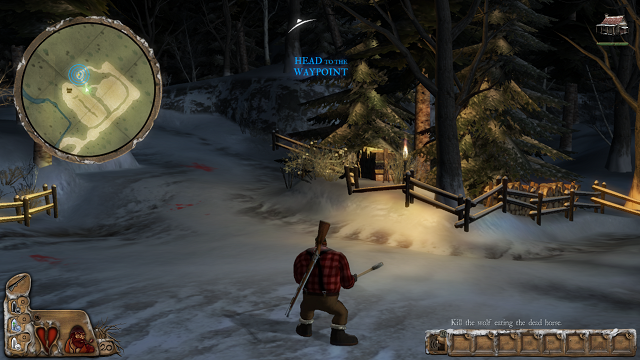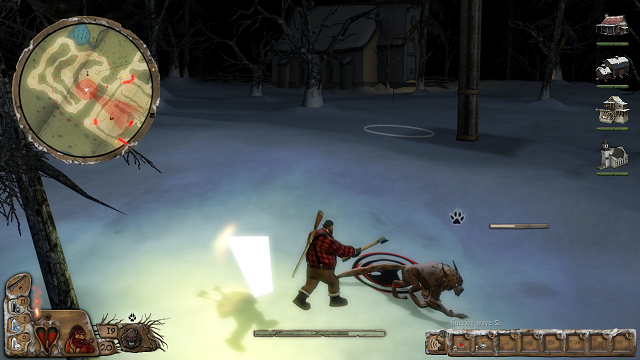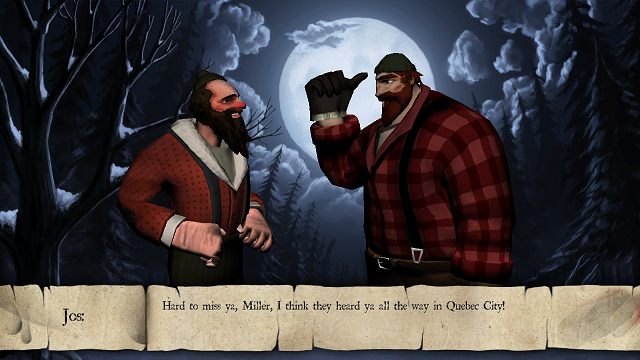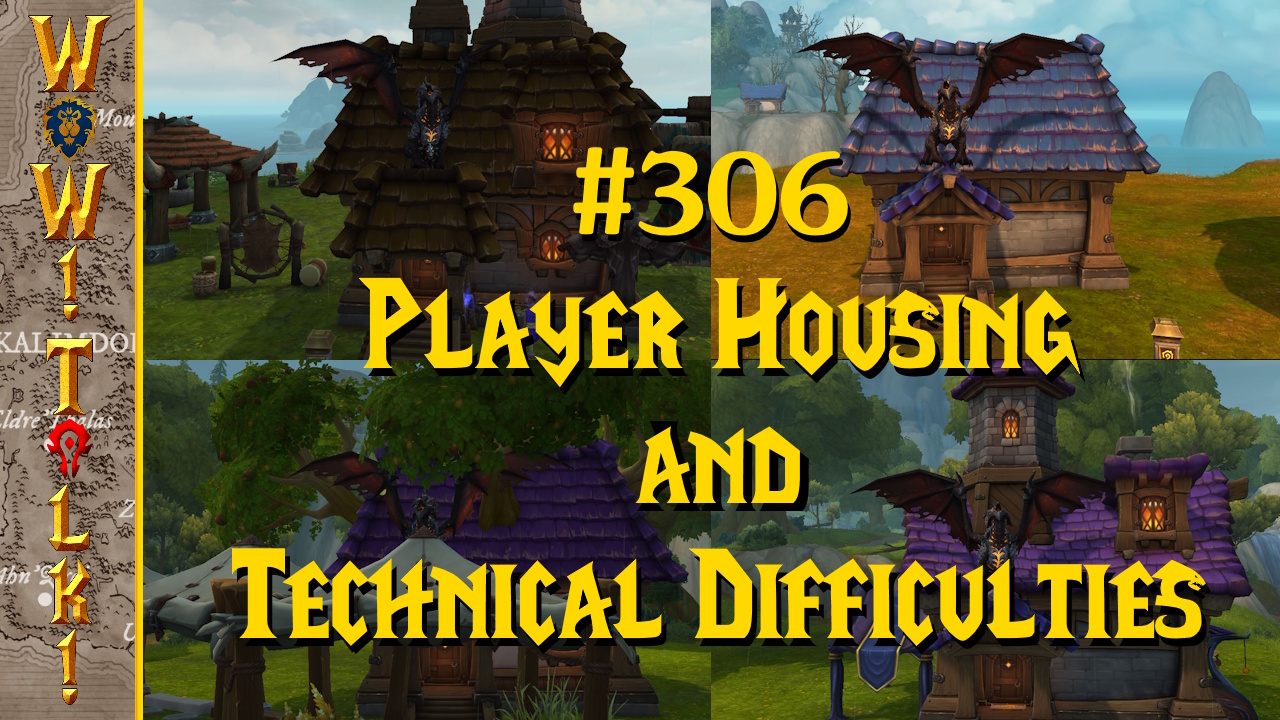
If you ever find yourself looking at the map in Sang Froid: Tales of Werewolves and thinking “I got this”, then you haven’t been paying enough attention. This combination tower defense/action RPG does not screw around with its players, and failure is just a few botched tactics or attacks away. You need to put serious thought into the stages, spending more time looking over the map than you will playing the level itself. When it comes together, though, it’s a magical experience to hear your traps going off in the distance while you fight with a Grand Werewolf with just an axe and a single-shot musket. There’s a lot to learn and keep track of, but it just feels so good when you can put it all together.
The game didn’t exactly start on the right foot with its super long loading screen. I would have been a lot more aggravated with it if it hadn’t been for the catchy song that plays while the game loads. The game takes place during the 1850’s in the wilderness of Quebec, Canada; so it leads in with this old, folk-styled song that just really gets inside of your head. It’s got a very specific feel to it that appeals to the maritime Canadian in me, and I found myself humming it for days afterward. A lot of the music in the game is infused with that same feeling, so you get a lot of different instruments like the accordion playing throughout the game. It really grounds the game in its period and just seems like a suitable fit for fighting werewolves in the Canadian wilderness.
I thought that last sentence was going to be a weird one, but the fact that I’m fighting werewolves in 1850’s Quebec is weird enough on its own. Given the time period, your weapons for fighting off the werewolves are somewhat limited. This isn’t one of those supernatural games where the heroes have built these intricate weapons specifically to deal with the creatures. At best, you can hope to get a silver bullet or a blessed woodcutter’s axe, but that’s all you’ll have for personal armaments. Oh yeah, and most guns only allow for one shot before you have to reload them… Using powder and a ram rod. I don’t think I have to tell you that you’d better make that first shot count.

Only being able to take a single shot means you’ll be in melee a lot of the time, but the system in place is pretty impressive. One of the most important things to manage is your fear meter, which shows just how scared the wolves are of you. It shows a picture of you and your enemy coming together, and the closer those pictures are the less afraid the creatures are of you. As long as the creature is scared it won’t attack, and it’s something you can amplify by using your shouting ability or by lighting bonfires. You can make it worse by standing close to enemies, as this agitates them and makes the fear bar drain faster. The bar is also affected by how many creatures are backing the first one up, so you really have to watch it.
You also have to keep your eyes on your stamina bar. Attacking or dodge rolling both drain your stamina, and if it completely empties then it takes longer to refill. If you’ve got nothing in the stamina bar you can’t attack or dodge, so you can’t just slam the enemies or dodge indefinitely. If you ever need to build some stamina back up or reload your gun you’ll have to manipulate the fear meter to buy yourself some time. It created this neat ebb and flow to combat where I wasn’t just concentrating on hitting the enemies. I’d have to go in, take a few swings, then move out to range and watch the pack circle me for a bit. You don’t really have a lot of intricate moves you can do with your axe, but having to keep track of all this stuff kept combat from getting stale. I loved the combat in the game since there was so much going on in the background, and I just felt like my brain was always active instead of shutting down like it might in some action games.
It’s not as simple as just keeping yourself alive, either. In Sang Froid: Tales of Werewolves, your job is to make sure your sister stays safe during the nightly werewolf attacks, so you have to keep an eye on the building she’s in. You also need the rest of the farm for your livelihood, so you can’t let that get too damaged either. Then the guy down the road says he’ll help you make more money if you can protect him. Then a ghost asks you to help him rebuild and protect his church, and before you know it your nightly watch covers a huge area and tasks you with keeping multiple buildings safe. These buildings aren’t all that durable either, so don’t expect any one building to be able to survive more than thirty seconds of direct attack. When you factor in that they’re spread all over a large map, you have a huge problem.

Managing that problem is where the game is at its most interesting. Now, if you tried to protect all of the buildings yourself you’d go crazy, but you can set a variety of traps to catch the enemies instead. You’re doing a little better than guessing at where you’d need to set those traps, too, as your sick sister also happens to be able to see the future, so you get a map at the start of every level that lays out where the wolves are coming from, where they’re going to attack, and what route they’re taking. I thought that would make my life easier, but all it does is make these levels possible. There are a lot of routes on each map, and knowing the exact behavior of the creatures is imperative if you’re going to build up a proper defense against them. The developers at Artifice Studio know you know the entire attack plan each night, and they’ll push you to your limits each time because of it.
Knowing what is going to happen doesn’t make it easy to stop all of it, and that’s where your traps come in. You have a small variety of them, but they all work extremely well in tandem to help you get through each level. You have simple wolf traps, but those don’t do much besides kill weaker wolves and aggravate stronger ones. You’re better off using spike traps which cover a huge area, but they only trigger if three creatures step into their area. It might be smart to drop some bait into the spike trap to guarantee a bunch of enemies enter into it, or create a fire wall that blocks off all other paths except the ones that lead into your trap. You can set up a rock-filled net as well and drop it onto your enemies with a shot, but you need to be there with your gun loaded to set it off. The same goes for the damaging crosses on the side of the road, as they won’t do anything unless you’re there to trigger them.
You can’t just set up traps wherever you like, either, as they cost action points and money. You have a limited pool of action points to use based on how many buildings you’re protecting, so you can only put out so many traps per night. If the traps cost you money then they stay for the next night, which is actually really cool, but you don’t get a lot of money in the game so you have to be really careful with how you spend it. On top of that, you can trade unused action points for money, so the game encourages you to be as thrifty as possible while still beating the stage if you want to buy better equipment for your character or better traps for the next level. It creates this delicate balance where you’re trying to beat each level as cheaply as possible, something that resulted in a lot of failures. There’s no penalty for losing except having to start the level over again, thankfully.

You can’t just fall into a set series of traps to get through, either. The enemies all have differing weaknesses or trap/weapon immunities, so each time you play you’ll be spending quite a bit of time analyzing the enemy strategy and what is effective against them. If you’re tactically-minded on any level, this is easily the best part of the game. Clicking on each enemy, watching its path and learning its weaknesses, and then designing a specific plan that will slow it down, kill it, or alter its direction just feels great. It’s beyond satisfying to hear the snap of one of your traps going off in the distance, knowing that you’re stopping actions that are all the way on the other side of the map because you outsmarted the enemies.
Even when you do take a lot of time to set these plans up, things can and will go wrong. Most traps have some activation criteria involving you being there or having a set amount of enemies step onto them, so you’ll need to be all over the place running interference. Zip lines are given to you in later chapters, but you still need to have a strong knowledge of where you need to be at each stage of the level. You have to be there killing enemies, setting off traps, and then rushing to the next spot. The only reason you’ll have enough time to do any of this is if you planned well, so you’d better have come up with a plan that dealt with everything. Since no plan is ever that perfect, expect something to go wrong as an enemy finds a different path or isn’t quite killed by one of your traps. Be ready to rush somewhere to deal with a problem you didn’t anticipate.
I never beat a single level in the game with anything even close to a comfortable margin. I’d get a few kills the way I wanted, but most of the time I’d set my traps in places I couldn’t get to or a different enemy group would trigger a trap that wasn’t meant for them. I’d often find holes in my plans and then have to work with what I had left. In one mission to rebuild the church the wrong enemies triggered a spike trap on a path I’d left for the final wave of enemies, leaving only one distant trap left by the time a huge wave of powerful werewolves showed up. I had to shout at them to get their attention, and then bolt toward the trap while hoping my stamina or health wouldn’t run out. They dogged me the entire way chewing at my health the whole time before I made it to the trap. I had no stamina left so I couldn’t roll once I’d made it there, so I just crossed my fingers and ran through it; hoping for the best.

The intricate plans and the thrill of making those plans work with almost no time to spare makes this game incredibly fun and engaging. It mixes the fun of an action game with the mind of a tactical one, creating this neat experience that will leave you gasping in relief every time you beat a level. Balancing all that out is a system that encourages you to finish a level with as few traps as possible so that you can use them in the later stages or be better able to outfit your poor lumberjack. The game just feels like you’re always maintaining a complex balance of a number of things, and when your shoestring budget plan comes together it’s hard not to jump out of your seat and cheer.
Winning in this game feels earned, and it’s a sensation that I doubt any player would get sick of. Combining that with the unique era, music, and visuals and you’ll get a game that really stands out. As long as you can handle losing over and over again while you improve your tactics, this game will not disappoint you. I rarely play tactical games because I feel like they’re games of broad strokes – ones where I can set up the plan but then can’t do much to fix it when it goes wrong. This game made me feel like every trap and movement was mine to see through – that I was directly involved in every step of my victory. You really get to savor every part of your win in Sang Froid:Tales of Werewolves, and I love it because of that.




